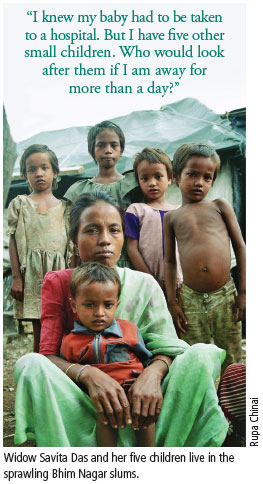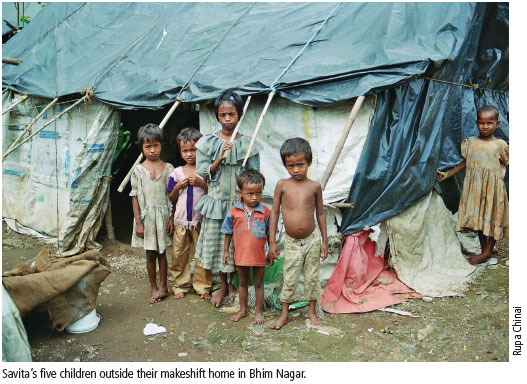NEWS
Getting health care to vulnerable communities
Rupa Chinai
Mumbai
More research is needed into why vulnerable communities fail to access public health-care services even when these are available. This lack of access proved to be tragic for Mumbai slum-dweller Savita Das and her family.
On 26 July 2005, when Mumbai was flooded within hours, Savita Das, 35, faced a decision no woman should have to make. Savita's 10-month-old daughter had fallen into the dirty floodwaters and urgently needed to be taken to hospital. The child was already suffering from severe malnutrition and the floods made her diarrhoea and respiratory infection even worse.
But as a widow living with her six children in a slum on the edge of the city, Savita had no choice but to watch her youngest child die. She recalled with sadness how she named that child "Lucky" in defiance of the family's already bad fate.
"I knew my baby had to be taken to a hospital. But I have five other small children. Who would look after them if I am away for more than a day?" Savita said, referring to her daughters: Sujata, 9, Supriya, 6, and Kantari, 5; and sons: Amar, 4, and Chaman, 2, who were also malnourished and unwell before the floods.
"If I take time off from work, how will I feed them?" said Savita, who earns around 50 rupees (about US$ 1) a day, after eight hours of back-breaking work at a scrap warehouse, separating plastic and other products that are used by the recycling industry.
Savita's story illustrates one disconnect, among many, that sometimes exists between public health policy and practice. While the Indian government's health policy is aimed at helping women like Savita, in practice such people often fail to access available health-care services for a number of reasons.
Addressing this disconnect is vital for making public health services more equitable in developing countries. This was a core issue at the annual meeting of the Global Forum for Health Research in Mumbai, 1216 September, attended by 700 international researchers and public health experts whose theme was "poverty, equity and health research".
The Geneva-based nongovernmental organization (NGO) campaigns for more research and development funding for the diseases of the poor and more funding for research into how to improve service delivery to vulnerable communities like Savita's.
Just weeks before the flood hit Mumbai, a local NGO, the Society for Nutrition, Education and Health Action (SNEHA), demonstrated how, in practice, such research can indeed come to the aid of vulnerable and impoverished communities. They and others involved in similar work believe that research into health systems and how they function on the ground can save lives in such communities.
In a study of six wards in Mumbai, the NGO identified Bhim Nagar as one of the most vulnerable communities because of its lack of access to basic shelter, hygiene and health care.
In the absence of these basic services, the group knew that even though the slum was not one of the worst flood-affected areas its people were likely to suffer more than those living in better-served parts of the city.
A team of doctors and social workers from SNEHA reached Bhim Nagar on the third day after the deluge. They brought food, medical aid and counselling, but it was too late to save Lucky, who died on 4 August.
The group's research findings ring true for Savita. When Savita's mother died because the family could not afford medicines to treat her high blood pressure, Savita's children lost their support system while she and her husband were out working.
Seven months later, Savita's husband Kewal, a construction worker, died of gastric-related problems. His daily pay of 60 rupees barely provided the family with a frugal diet of rice and lentils and certainly not enough to buy the drugs prescribed for him by government hospital doctors.
"Savita's inability to access timely health services for her child is a consequence of her circumstances," said Dr Armida Fernandez from SNEHA, calling for the provision of mobile health services to such communities.
Savita's family are Bengali speakers who came to Mumbai from Assam. They are among some seven million urban poor who constitute 60% of Mumbai's population of 12 million. They live on the streets, in slums, tenements and dilapidated buildings.

Communities living in slums established before 2000 are provided with basic health-care services, but unregulated ones like Bhim Nagar that have sprung up since then are subject to evictions and are not provided with basic services, such as clean water, health services, schools, electricity and ration shops.
Bhim Nagar is built on a vast marshy swamp, and patients requiring medical care must be carried for 30 minutes along a dirt track before they reach the road and transportation.
"Reaching a government hospital does not save their lives. They are asked to purchase expensive drugs from outside, made to run from pillar to post and wait in long queues," said Sangita Kamble, a social worker who works in Bhim Nagar. "Those who have money prefer going to private doctors or quacks. The rest, like Savita, give up hope."
Mumbai has one of the wealthiest municipal authorities in India. Its health-care services are, however, stretched beyond capacity because of a rapidly growing population and a state government freeze on recruitment of new health staff over the last six years, said Jairam Thanekar, Deputy Executive Officer of the Mumbai Municipal Corporation.
This situation is severely affecting primary and secondary care services where limited staff shoulder the burden of having to implement all "vertical" or single-disease programmes, said Dr Girish Ambe, Deputy Executive Health Officer for Tuberculosis. The main vertical programmes are on family planning, polio, AIDS, tuberculosis, malaria and immunization.
Thanekar said the city would benefit from research into a number of disconnects in the health system. For example, research on how to develop human resources because low motivation and morale among health staff are major obstacles faced by patients seeking public health-care services.
Ravi Narayan of the People's Health Movement, an international NGO, said an important message that emerged from the Global Forum's meeting, Forum 9, was that communities need to become more involved in shaping research agendas. Evidence from Africa and Asia shows how research that brings together statistical data with information on what communities want, based on interaction and sharing knowledge with them, can spur more active involvement of communities. This would make health policy and service delivery more effective, he said.
Lot Nyirenda, a scientist with Research for Equity and Community Health Trust in Malawi, agreed that it is vital for local research to help determine what are the priority concerns of a developing country: "Policies for research and equity need to be developed in a manner that is participatory and relevant to local needs. It should aim at reaching the most marginalized segments of the population by ensuring mechanisms that provide proof of delivery".
Bhim Nagar is one of many communities across Asia that would benefit if user fees for health-care services were eliminated and if budgets were increased to strengthen the public health system. Savita's poignant story of failing to access life-saving health care is repeated in many places across the world.

A study called Equity in Asia-Pacific Health System (EQUITAP) looking at 15 Asian countries including India that was presented at Forum 9 found that charging user fees and withdrawing public sector money to fund health care for the poor were resulting in catastrophic out-of-pocket expenditure for the poor, plunging them into indebtedness and deeper poverty.
WHO estimates that worldwide 180 million people suffer financial catastrophe every year because of user fees for health care and because of these fees, some 105 million people are impoverished.
Stephen Matlin, Executive Director of the Global Forum for Health Research, said that many countries fail to provide universal access and free services, and the limited resources that are spent on health are not well targeted. "A relatively large proportion of the public resources benefit the better-off rather than the poor in society," Matlin told the Bulletin.
"The research challenge lies in how to redirect public resources to the poor," Matlin said. 
